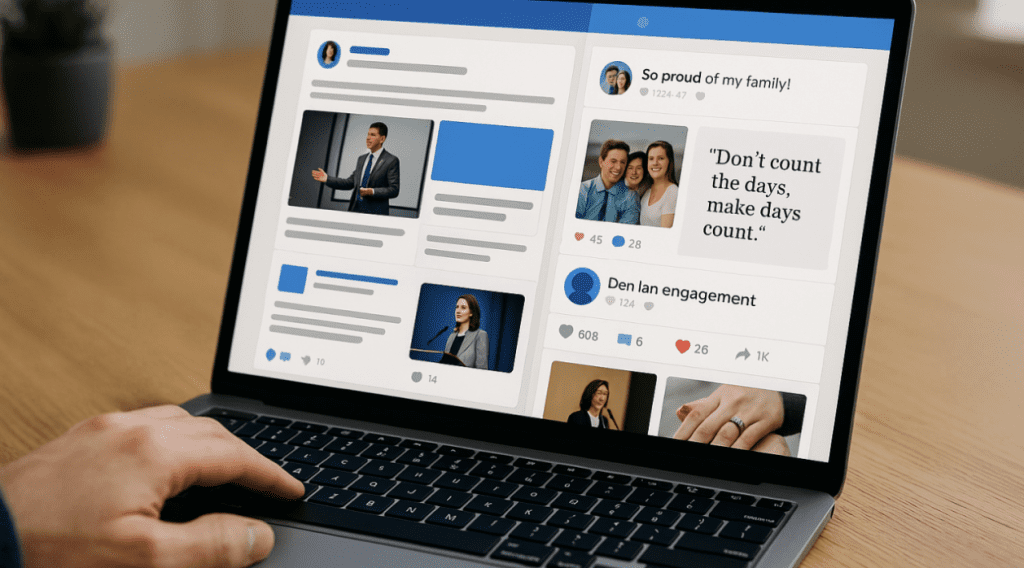Is LinkedIn Becoming the New Facebook?

Somewhere along the way, LinkedIn — once a place for job hunting, industry updates, and the occasional humblebrag about promotions — started to feel… familiar. And not in the good way. If you’re getting déjà vu from the golden days of Facebook (life updates, inspirational quotes, engagement bait, and oversharing disguised as professional insight), you’re not alone.
For a growing number of users, LinkedIn is beginning to resemble a corporate version of Facebook. And it’s not just the tone or content — it’s the frustration with the algorithm itself that’s drawing the comparison.
I don’t say this as a casual user. Back in 2012, I was included in LinkedIn’s inaugural Power Profiles – Australia list. I’ve seen the platform at its best — a place where professional voices could cut through and shape meaningful conversations — which makes its current drift all the more frustrating.”
The Algorithm No One Can Trust
Recently, Cindy Gallop — a highly respected, long-time LinkedIn voice with a large following — posted this:
“PSA: Those of my over 135,000 followers who actually get to see my posts on here (very few, judging by the impressions) will know that my posts appear to be algorithmically challenged — or challenging.
LinkedIn are currently undertaking the second of two formal investigations I’ve requested into how the math does not math…
But I’m not going to change a thing about ‘my LI strategy’.
I’m just going to carry right on being myself.”
This isn’t a fringe complaint. It’s a sentiment echoed across the platform — by independent creators, founders, journalists, coaches, and mid-career professionals alike. They’re not gaming the system. They’re just tired of feeling like they have to.
Because let’s be honest: when you spend years building an audience, only to have a tiny fraction of them actually see your posts, the problem starts to feel less like engagement and more like suppression. And unlike Facebook — which I abandoned years ago when it turned into a dumping ground for family photos and marketplace spam — LinkedIn still insists it’s about professional growth, visibility, and thought leadership.
So why is the algorithm penalising authenticity?
Virality Over Value?
LinkedIn says it wants meaningful content. But what it seems to reward are posts with neat spacing, leading questions, and an emotional hook that pulls at professional heartstrings:
- “I was laid off today — and it’s the best thing that’s ever happened to me.”
- “I met someone on the train who changed my entire approach to leadership.”
- “My 5-year-old just taught me everything I needed to know about startup funding.”
This isn’t to dismiss the power of storytelling. Stories are how we connect — in fact, I’ve written a book about their vital importance. But when storytelling becomes a template to hack the algorithm — when every second post feels like a bait-and-switch — it’s easy to see how the feed starts to feel less like a community and more like a stage.
Performative Professionalism and the Discomfort of Authenticity
It’s a strange contradiction: LinkedIn is pushing people to “bring their full selves” to work, but punishing those who do it too earnestly.
Cindy’s aim isn’t to go viral; she’s sharing the work that matters to her, from advocating for female founders to spotlighting open speaking opportunities. And yet her reach is throttled, while listicle-style fluff gets bumped to the top of the feed. I’ve heard this same frustration from professionals who’ve been on LinkedIn since the early days — what once felt like a merit-based network now often rewards theatrics over substance.
When serious discussions about funding gaps, online abuse, or workplace safety are throttled — while fluff thrives — the signal-to-noise ratio becomes more than an inconvenience. It undermines the trust and safety of the community itself, leaving critical conversations buried.
What does that say about what kind of “professional” voice we actually reward?
So, Is It Fair to Compare LinkedIn to Facebook?
In some ways, yes.
- Both platforms now prioritise engagement over intention.
- Both encourage users to perform for the algorithm rather than communicate with their networks.
- Both generate frustration when organic reach is limited, without transparency or control.
But in other ways, LinkedIn is still distinct. The stakes feel higher. The personal brand you build here can affect your funding round, your job prospects, your credibility.
And that’s exactly why this shift matters.
What Are the Alternatives?
There’s no true one-for-one replacement for LinkedIn — and that’s part of the problem. But depending on your goals, there are other spaces to explore:
- Substack or Medium if you’re looking to write longer-form thought pieces.
- Polywork or Lunchclub if you’re focused on high-quality networking.
- Slack/Discord groups or Reddit for niche discussions without the algorithmic fluff.
- Bluesky or Mastodon if you’re exploring decentralised or emerging communities.
But for now, most of us stay on LinkedIn. Because we have to. Because we’ve invested in it. Because there’s still good here — buried beneath the optimisation.
So, What Should We Do?
There’s no perfect answer. But perhaps, like Cindy, the only strategy worth sticking to is:
- Be yourself.
- Don’t chase formats that don’t suit you.
- Speak to your people, even if fewer of them hear you.
Yes, the algorithm is a mess. Yes, the feed feels increasingly like Facebook. But unlike Facebook, LinkedIn still has the chance to course-correct — if we remind it, and ourselves, why we came here in the first place.
To connect.
Genuinely.
Professionally.
And personally, too.
About the Author:

Kim Chandler McDonald is the Co-Founder and CEO of 3 Steps Data, driving data/digital governance solutions.
She is the Global VP of CyAN, an award-winning author, storyteller, and advocate for cybersecurity, digital sovereignty, compliance, governance, and end-user empowerment.